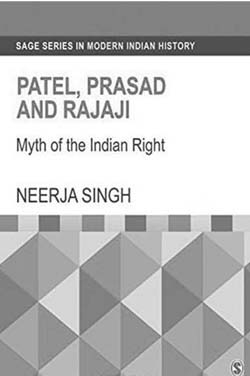Since the days of her research under the late Professor Bipan Chandra in the 1980s to the publication of Patel, Prasad and Rajaji: Myth of the Indian Right, Delhi University historian Neerja Singh has been engaging with the ‘right-wing politics in the Congress’. Critiquing the ‘Left’ historiography for clubbing Sardar Patel, Rajendra Prasad and Rajagopalachari under the Right Wing fold of the Congress, she offers the argument that these three key leaders of the Congress, instead, believed in a ‘liberal democratic welfare state’, ‘secular citizenship’, ‘cultural pluralism’, ‘religious tolerance’, and ‘coexistence’. Besides, they took a ‘progressive’ approach and a ‘pro-people orientation in the scheme for nation-building’.
To begin with, she interrogates the category of ‘Right’ and claims that it has a ‘specific European lineage’. Terms such as Right, in Singh’s view, is ‘abstracted from the Western context’ that referred to ‘reactionary forces’ in Europe. As the author puts it, ‘The Right in the West, in fact, took shape under a specific historical context and under certain constraints of development. It was seen as a post-liberal, post-industrial phenomenon, a reaction to the liberalization of political life, a protest against shrivelling markets, overproduction and apathy towards democracy. Another variant of European Right also practised and propagated the theory of eugenics and anti-Semitism’ (p. 3).
Put differently, the Rightist forces of Europe, in her view, advocated ‘conservatism’ and favoured ‘delimiting progress, freedom and individualism’. Moreover, they were ‘anti-people’, ‘anti-democracy’, ‘anti-intellectual’ and ‘anti-socialism’.
Afterwards, she moves to take pot-shots at her Leftist opponents for pinning the label of the Right on Patel, Prasad and Rajaji. According to her, such an act was part of the Left’s ‘ploy’ to put them on the ‘defensive’ and push them to take a ‘rear seat’ in the Congress. In short, the exercise of calling them as Rightist is based on ‘more political and ideological’ considerations other than ‘historical’ ones.
Having slammed the Left for branding the trio as Rightist leaders, Singh praises their ideas and contributions: they were ‘liberal democrats of moderate genre’, who ‘rejected’ obscurantism and ‘social ills’. Moreover, they held an ‘inclusive’ worldview and secular attitude towards caste, gender and religious minorities and ‘wanted Congress to seriously take up social issues such as untouchability, education, dowry, child marriage, widow marriage, purdah, prohibition, rural indebtedness, conversion, ritualism and personal hygiene’ (pp. 19–37).
One of my major disagreements with the author’s formulation is about her application and rejection of ‘Western’ categories at her convenience. For example, while the author vehemently criticizes the Left for employing the term Right for Patel, Prasad and Rajaji, she, at the same time, can’t help but hail the trio with the same western concepts, i.e., liberal, democrat, secular and progressive.

